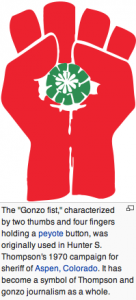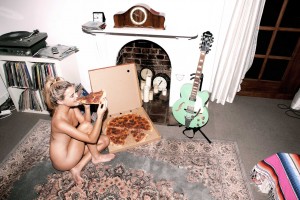For this critical essay, I was asked to pursue a research question that will enhance my understanding of a topic area that is of key interest to me and will have direct relevance to my future career. Having always been fascinated by any kind of documentary, I decided to focus my essay on TV documentaries, and especially gonzo journalism. I was unfamiliar with this new term «Gonzo», which is why I’ve chosen to do some deeper research into this aspect of journalism, as it’s a big interest of mine. So what exactly is Gonzo journalism, what differentiates it from regular journalism? And in what way do we use it? These are a few questions that I intend to answer within this essay.
My interest with journalism and especially TV documentaries started when I was really young and had the chance to see a recording for a television documentary series called Thalassa. This series is entirely focused on the sea. It started in 1975 and is still running, making it one of the oldest but most prominent TV programmes in France.
In gonzo journalism (also called outlaw journalism), a journalist is free to participate in events and circumstances which may be considered newsworthy.
I like to think Nellie Bly was a precursor of that kind of journalism. She was a reporter known for her record-breaking «Trip around the world in 72 days», in emulation of Jules Verne’s character Phileas Fogg. Nellie Bly was an inspiring woman having managed to make her way through journalism when it was a man’s field only. She was a pioneer in her field. Not only did she turn news paper reporting into investigative journalism, but she also led fights for women’s rights.
https://www.youtube.com/watch?v=H0iAan0ei0Y
Nellie Bly, a pioneer of gonzo journalism?
In 1887, Elizabeth Jane Cochrane from her real name, agreed to fake insanity to investigate reports of neglect and brutality at the women’s Lunatic Asylum on Blackwell’s Island. Her report, later published in a book entitled «Ten Days in a Mad-House» caused a sensation and brought her lasting fame.
On the effect of her experiences, she wrote: «What, excepting torture, would produce insanity quicker than this treatment? Here is a class of women sent to be cured. I would like the expert physicians who are condemning me for my action, which has proven their ability, to take a perfectly sane and healthy woman, shut her up and make her sit from 6 a.m. until 8 p.m. on straight-back benches, do not allow her to talk or move during these hours, give her no reading and let her know nothing of the world or its doings, give her bad food and harsh treatment, and see how long it will take to make her insane. Two months would make her a mental and physical wreck.»
 BUT WHAT EXACTLY CHARACTERIZES GONZO JOURNALISM?
BUT WHAT EXACTLY CHARACTERIZES GONZO JOURNALISM?
Gonzo journalism is a style of journalism that is written without claims of objectivity, often including the reporter as part of the story via a first-person narrative. The word “gonzo” is believed to be first used in 1970 to describe an article by gonzo journalist forefather Hunter S. Thompson, who later popularized the style. It is a first-person writing style in which the author is a protagonist, and draws its power from a combination of both social critique and self-satire. It has since been applied to other subjective artistic endeavors.
.
In gonzo journalism, there are no set rules, though like most writers, Thompson follows a successful style and framework. Thompson’s own definition of it has varied over the years, but he still maintains that a good gonzo journalist
needs the talent of a master journalist, the eye of an artist/photographer and the heavy balls of an actor
and that gonzo is a “style of reporting based on William Faulkner’s idea that the best fiction is far more true than any kind of journalism».
Thompson was non-traditional in every sense of the word, including his journalistic style: rather than just accept an editor’s assignment, he would rather be intimately involved with the events and people he was covering. Though the style lends itself to subjectivity, it also allows for a broader picture to be developed and shared. Thompson seemed to be advocating a more independent and active form of journalism only hinted at before in the works of New Journalists of the time. But with a style that seems to be rooted in such irregularity, subjectivity, and even eccentricity, can Gonzo journalism really be taken seriously in a field dedicated to the honest and faithful pursuit of truth?
Absolutely. In fact, Gonzo journalism is a necessary journalistic style and is an extremely effective and essential method of information collection and dissemination in journalism.
In order to examine Gonzo journalism as an effective journalistic style, a closer look at some Gonzo journalistic texts is necessary.
In his article “What’s Gonzo about Gonzo Journalism?”, Jason Mosser argues that Thompson is the “one true Gonzo journalist.” Mosser discusses several key elements of Thompson’s Gonzo journalism, all of which can be found in the pages of Sacco’s graphic novel as well : presence of a first-person, autobiographical narrator who assumes the role of protagonist, participation of a male bonding figure, deviations from the actual story itself in favor of personal matters..
As gonzo journalists interact with the people and events they are covering, the “recording model” no longer exists and it allows for a greater development of the subject at hand. Does gonzo journalism have something to do with creating more than following a script? That is what makes it interesting.
A vital facet of effective Gonzo journalism is the ability to not only entrench oneself right in the middle of the action, but to become fully participatory in it as well. In his documentary covering the 1972 presidential campaign “Fear and Loathing on the Campaign Trail ’72”, Thompson finds himself in the middle of quite a few promising, situations for example.
I did some research and questioned myself. But what really defines gonzo journalism? What are the characteristics? Mainly based on Louis Theroux (and also Australian gonzo journalist John Safran) documentaries and after having watched almost every episode, I found characteristics that in my opinion, are relevant to gonzo journalism :
– themes of sex, violence, drugs, sports and politics.
– references to public figures such as newspeople, actors, musicians and politicians
– a tendency to move away from the topic subject or subject he started out with
– use of sarcasm or vulgarity as humor
– extreme scrutiny of situations
Louis Theroux could not be a better example. He is the man who asks the weird questions we all want answered. In addition to the characteristics found for gonzo journalism, I have decided to pick two different documentaries – one gonzo, one traditional – and compare them. Both documentaries deal with «The most hated family in the USA». The first documentary was made by VICE, the second one by Louis Theroux.
The first obvious difference is that VICE does not have a host. Louis Theroux is the host on his show and interacts with the interviewees. It gives it a more personal aspect (he also lives with them). He’s completely immersed in their lifestyle.
Also, VICE documentary was centred on the topic only (which was the ‘cult’ and hatred for America) whereas Louis Theroux was much more open and moves away from topic subject sometimes which get us to know more about the family and the way they live in society.
What also made it more ‘real’ with Louis Theroux is that he can never expect what is about to happen > when the little kid gets a bottle of soda thrown at his head because he was holding a panel. And finally, something that was found in the VICE documentary but not in Louis’ is an interview of people not agreeing with this family. The two interviewees used to be apart of the cult but quit and now share their experience.
But why do we use that kind of journalism and why has it become so popular?
Well the purpose of gonzo journalism would be to produce a brutally honest or highly subjective journalistic piece based on the real experience of a reporter writing from the inside. Moreover, a gonzo journalist is not necessarily protected from law enforcement efforts, so even the legal ramifications of the journalist’s actions could become part of the news story.
CONCLUSION: Through the use of participatory information collection, and quasi-realistic art, Gonzo journalism has allowed for the development of stories to which many in the mainstream public would never otherwise be heard. Gonzo journalism also but especially has provided a closer look into foreign and counter cultural lifestyles. Thompson’s Gonzo journalistic work wrangled his ‘behavior’ and eccentricity into something nowadays structured and meaningful. I will conclude with a wise quote from Thompson, “When the going gets weird, the weird turn pro.”
1482 WORDS






